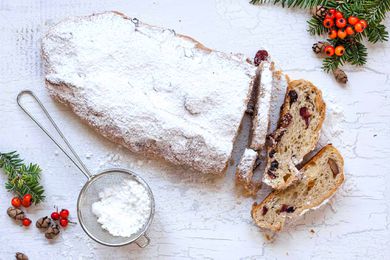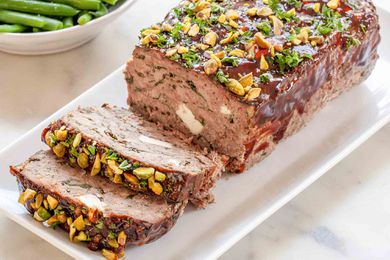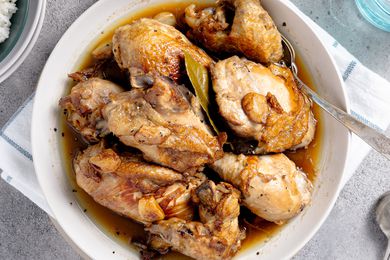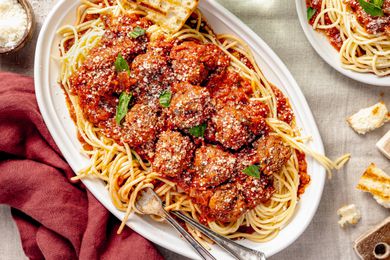:max_bytes(150000):strip_icc()/Simply-Recipes-Goetta-LEAD-4-84fecc377bb341a595881c8c358239b2.jpg)
Simply Recipes / Ciara Kehoe
Cincinnati is one of my all-time favorite cities. It has awesome museums, libraries, restaurants, and bridges. And, just as importantly, it has goetta.
What is goetta? This highly regional food is essentially a simple pork and beef sausage stretched out with oats. It’s sliced and griddled until crispy and most often served at breakfast with eggs and toast.
But this summary majorly underplays goetta’s appeal, which is not simply as an obscure breakfast meat. Cincinnatians are devoted to goetta as more than a food; it’s also a living relic of the city’s rich history, one that continues to evolve. Though goetta’s origins are German, today Cincinnati’s diverse population showcases goetta in inspired multicultural preparations.
Making your own goetta takes time, but it’s not hard. Plus, the investment in ingredients will cost you less than the shipping for a pound or two of ready-made goetta from any number of Cincinnati’s favorite purveyors. Then you, too, can savor the goetta experience in your own home over and over again.
:max_bytes(150000):strip_icc()/Simply-Recipes-Goetta-SEO-74e94320c3404af49a255cda503b2566.jpg)
Simply Recipes / Ciara Kehoe
How To Say Goetta
First things first! It’s pronounced “get-ah”. Go ahead and say it out loud a few times to practice. Yes, it is ripe for puns. Have fun.
Where did this word come from? Cincinnati had an influx of German immigrants in the 19th century, and this can still be seen in many street and business names there today. But goetta itself traces back to immigrants from Germany’s Westphalian region specifically.
The Origins of Goetta
Polishing up my default goetta recipe gave me an excuse to reread Cincinnati Goetta: A Delectable History, the exhaustively researched goetta deep dive by my food nerd crush, Dan Woellert. In it, he traces goetta’s roots to grain-based sausages common in farming villages of Westphalia, where they’d stretch the meat from butchering a hog with cooked buckwheat.
Buckwheat wasn’t as easily found in Cincinnati, so the Westphalians who came to the area in the late 19th century made do with oats. As urbanites, they also didn’t have their own hogs to slaughter, but Cincinnati’s flourishing pork butchering industry (the one that gave rise to the nickname Porkopolis) meant they did have access to all the stuff left from processing a pig. They adapted the grain-based sausages of their homeland and, like all treasured immigrant food, a unique new recipe evolved from an old one.
Woellert has his grandmother’s goetta recipe, which she in turn credited to her mother, and he notes that family relatives used pork neck bones in their goetta. “Which nobody in their right mind would use, because it takes forever to pick the meat off,” he tells me. “But at the time, back in the turn of the last century, that was a cheap cut for working-class families, so it made sense.”
Variations from family to family are part of goetta’s lore. “The earliest goetta recipe, the seasoning only calls for salt, pepper, and allspice,” says Woellert. But in the goetta recipes he collected, he found a wide range of aromatics: garlic, ginger, cinnamon. “One recipe had raisins in it. You can trace that to the city of Bramen, because they are known for a goetta ancestor called knipp that uses raisins.”
:max_bytes(150000):strip_icc()/Simply-Recipes-Goetta-LEAD-7-8252aad06425482d913dfafb83330724.jpg)
Simply Recipes / Ciara Kehoe
Goetta Culture in Cincinnati Today
Cincinnati is a city that knows how to rock its underdog status. Perhaps even more so than Cincinnati chili, humble goetta is emblematic of Cincinnati pride in all of its good things that fly under the radar of popular culture elsewhere.
Goetta is ubiquitous in diners there as a breakfast meat offering, and you don’t have to try hard to find a tube of Glier’s goetta (a local icon) at any grocery store. Glier’s sponsors an annual, hugely popular Goettafest replete with bands, goetta merch emblazoned with slogans like “Goetta Life,” and food stalls hawking goetta on hoagies, pizzas, nachos, and just about anything else you can think of.
Glier’s goetta is a solid choice, although as mass-produced as goetta gets. It has a hint of muskiness from the inclusion of pork hearts and skin. Perhaps a better introduction for wary newbies would be Eckerlin’s Meats, which makes goetta on a smaller scale and uses only ground meat, no organs or skin. Me, I don’t buy much goetta, because making this recipe has allowed me to conveniently stockpile it in the freezer for future cravings.
Goetta Ingredients
- Meat: Our recipe uses only ground meat, in part because pork hearts and skins are not only polarizing, but hard to come by. Earlier versions of goetta used, as the saying goes, “everything but the oink,” and were made not with ground meat, but tougher cuts of pork and pork variety meats that were simmered until fall-apart tender. You still see this variation in some homemade goetta recipes today, but most use ground meat. The pork skin in particular helps make a goetta that’s firmer, whereas goetta made with ground meat only is slightly crumbly. You can use all pork, as the original did, but a 50:50 mix of ground beef and ground pork lends a robust flavor. A pork and beef mix is the predominant composition of goetta recipes today.
- Oats: Pinhead oats are the historic precedent in Cincinnati. The once-preferred brand was from Dorsel’s, a regional mill. There was even a goetta recipe on the back of the bag. Pinhead oats are remarkably similar to steel-cut oats, so if you don’t want to special order hard-to-find Dorsel’s pinhead oats, use steel-cut.
- Seasonings: Bay leaves and onions are nearly required. So is pepper. Dried herbs such as sage show up in nearly every version. Some goetta recipes are quite light on the seasoning, while others go big. I took inspiration from the spice mixes used in traditional German bratwurst recipes and amped it all up for a robust, crave-able flavor.
:max_bytes(150000):strip_icc()/Simply-Recipes-Goetta-LEAD-6-53b6b3e0255444629b2e83c25e40b9a9.jpg)
Simply Recipes / Ciara Kehoe
Ways to Use Your Goetta
The reward for making goetta from scratch is getting to savor it in goetta-rific creations. Fried slices as a breakfast side are plenty delicious–crispy on the outside, creamy on the inside. But chefs and home cooks alike make Cincinnati a creative firmament of riffs on goetta dishes, many of them cross-cultural.
For the best taste and texture, always fry or griddle your goetta before adding it to other recipes. Here are some ideas to get you started:
- Topping pizza, in slices or crumbles
- Starring as the protein in fried rice
- Filling sandwiches, especially egg and cheese breakfast sandwiches
- Enriching egg dishes like frittatas, scrambles, and omelets
- Enlivening casseroles like hash brown casseroles or breakfast casseroles
- Upstaging everything else atop nachos
- Stuffing tacos and burritos
- Standing in for gyro meat
- Replacing the patty in a patty melt
More Classic US Regional Dishes
Goetta
Pinhead oats are whole oat groats that are cut into small pieces. Dorsel’s is the traditional brand used in and around Cincinnati. You can either order it online or use the nearly similar steel-cut oats, which you can find at most any grocery store.
If you don’t have poultry seasoning, use 1/2 teaspoon each of dried rosemary, marjoram, thyme, and sage.
Ingredients
-
4 cups water
-
2 1/2 cups pinhead or steel-cut oats (see recipe note)
-
2 teaspoons (10g) salt, divided
-
1 pound ground pork
-
1 pound ground beef (80/20 is good)
-
2 teaspoons poultry seasoning (see recipe note)
-
2 teaspoons onion powder
-
2 teaspoons garlic powder
-
1 teaspoon freshly ground white pepper (or substitute black pepper; I like a 50/50 blend of white and black)
-
1/4 teaspoon cayenne pepper
-
1/4 teaspoon ground nutmeg
-
4 cups low-sodium beef stock
-
2 bay leaves
Method
-
Cook the oats:
In a large, heavy-bottomed pot, bring the water, oats, and 1 teaspoon of the salt to a boil over high heat. Reduce to a simmer and cook uncovered, stirring often with a wooden spoon, until very thick and creamy, about 30 minutes.
![Oats in a Dutch Oven, Stirred With a Wooden Spoon]()
Simply Recipes / Ciara Kehoe
-
Mix the meat and seasonings:
In the bowl of an electric stand mixer fitted with the paddle attachment, combine the ground pork and beef, seasonings, and remaining 1 teaspoon salt. Mix on low speed until combined, about 1 to 2 minutes.
With the machine running on low, slowly pour in 2 cups of the beef stock and mix until sticky, about 2 minutes. Mixing the meats until they are sticky helps form a protein bond that’ll make your finished goetta less crumbly and have a more sausage-like texture.
Tip
If you don’t have a stand mixer, you can thoroughly knead the mixture together by hand.
![Ground Beef and Pork in Mixer Bowl With Mix Attachment After Being Mixed]()
Simply Recipes / Ciara Kehoe
![Meat Mixture in a Mixer Bowl After Being Mixed With Beef Stock]()
Simply Recipes / Ciara Kehoe
-
Add the meat mixture and stock and cook until very thick:
Transfer the meat mixture to the pot with the oats. Add the remaining beef stock and stir well to make a light pink sludge. Add the bay leaves, then raise the heat to medium-high and bring to a simmer, stirring constantly with a wooden spoon.
Reduce the heat as low as it can go and cook, uncovered, 1 to 2 hours, stirring every 5 minutes or so to prevent the oats from sticking to the bottom and scorching. It’ll slowly turn brown and then, as the liquid evaporates, it’ll look less like oatmeal and more like a chunky, brownish-gray peanut butter.
It should require more and more effort to stir the longer it cooks (if in doubt, cook longer). When it’s ready, it’ll be quite stiff, and you’ll easily see the bottom of the pot when you drag the spoon through the mixture.
Taste and adjust the seasoning, if needed; it should be salty the way sausage is salty. Remove the bay leaves and set the pot aside for now.
![Meat Mixture and Bay Leaves Mixed Into Pot of Oats With a Spoon]()
Simply Recipes / Ciara Kehoe
![Goetta Meat Mixture Cooking in a Dutch Oven, Consistency Still Slightly Liquid-y and Loose]()
Simply Recipes / Ciara Kehoe
![Goetta Mixture in a Dutch Oven With a Spoon, Consistency Thicker (No Liquid Leftover)]()
Simply Recipes / Ciara Kehoe
-
Fill the loaf pans:
Line the bottoms of two 8 1/2x4 1/2 or 9x5-inch loaf pans with parchment. Grease the pans and parchment with cooking spray.
Divide the mixture between the pans and smooth the tops. Let the pans cool on the counter for at least 1 hour, then refrigerate, uncovered, for at least 12 hours to set.
Tip
Leaving the pan uncovered allows the goetta to form a skin on top that helps it keep its shape when you slice it.
![Two Loaf Pans Lined With Parchment Paper and Sprayed With Cooking Spray]()
Simply Recipes / Ciara Kehoe
![Goetta Mixture Added to Each Loaf Pan]()
Simply Recipes / Ciara Kehoe
-
Wrap and store:
Slide a thin metal spatula between the parchment and the goetta to loosen it, then unmold the loaf and wrap it well in plastic wrap. Refrigerate for up to 1 week or freeze for up to 1 year.
Tip
For easy portioning, slice the goetta before freezing. Wrap several slices tightly in plastic wrap and then place the bundles in a large freezer bag so you can remove only as much goetta as you need at a time. Thaw the goetta overnight in the refrigerator.
-
Fry the goetta to serve:
Even though the goetta is fully cooked, it’s always served sliced and fried or griddled. Cut the loaf into 1/2-inch slices.
Heat 1 tablespoon of vegetable oil or bacon fat in a skillet (preferably nonstick or cast iron) over medium-high heat. Add the goetta, being careful not to crowd the pan, and cook 5 to 10 minutes per side, disturbing the goetta as little as possible so you don’t break up the crispy brown crust as it forms. You may need to lower the heat of the pan bit by bit to keep it from scorching.
Love the recipe? Leave us stars and a comment below!
![Set Goetta Sliced on a Baking Tray]()
Simply Recipes / Ciara Kehoe
![Goetta Slices Fried in a Cast Iron Skillet for Goetta Recipe]()
Simply Recipes / Ciara Kehoe
![Goetta Flipped on the Cast Iron Skillet]()
Simply Recipes / Ciara Kehoe
![Sliced Goetta Served With a Sunny Side Egg and Two Pieces of Toast]()
Simply Recipes / Ciara Kehoe
| Nutrition Facts (per serving) | |
|---|---|
| 128 | Calories |
| 7g | Fat |
| 7g | Carbs |
| 10g | Protein |
| Nutrition Facts | |
|---|---|
| Servings: 22 | |
| Amount per serving | |
| Calories | 128 |
| % Daily Value* | |
| Total Fat 7g | 8% |
| Saturated Fat 2g | 12% |
| Cholesterol 28mg | 9% |
| Sodium 294mg | 13% |
| Total Carbohydrate 7g | 3% |
| Dietary Fiber 1g | 4% |
| Total Sugars 0g | |
| Protein 10g | |
| Vitamin C 0mg | 1% |
| Calcium 18mg | 1% |
| Iron 1mg | 6% |
| Potassium 163mg | 3% |
| *The % Daily Value (DV) tells you how much a nutrient in a food serving contributes to a daily diet. 2,000 calories a day is used for general nutrition advice. | |

:max_bytes(150000):strip_icc()/Simply-Recipes-Goetta-METHOD-1-f4cfd210bf6444bb8414e0052d625b7a.jpg)
:max_bytes(150000):strip_icc()/Simply-Recipes-Goetta-METHOD-2-4f3024e76bf442c7909a8971bc17aa3b.jpg)
:max_bytes(150000):strip_icc()/Simply-Recipes-Goetta-METHOD-3-69d35a208b1e4c40b1dbcfb71237aa9f.jpg)
:max_bytes(150000):strip_icc()/Simply-Recipes-Goetta-METHOD-4-5f090905256a4ae7b3acb6a6ec59efa4.jpg)
:max_bytes(150000):strip_icc()/Simply-Recipes-Goetta-METHOD-5-96d0b45e26754683ae94d9a44aaf4ab8.jpg)
:max_bytes(150000):strip_icc()/Simply-Recipes-Goetta-METHOD-6-cc0eea6e1f1940b49a345f63429b1e2b.jpg)
:max_bytes(150000):strip_icc()/Simply-Recipes-Goetta-METHOD-7-c6d8ca03768d4c0786f9eaf501afaf9b.jpg)
:max_bytes(150000):strip_icc()/Simply-Recipes-Goetta-METHOD-8-8bd0ac949f7443bca24427473baf3dee.jpg)
:max_bytes(150000):strip_icc()/Simply-Recipes-Goetta-METHOD-9-8e975b10fb3040418c393b8502ede6cc.jpg)
:max_bytes(150000):strip_icc()/Simply-Recipes-Goetta-METHOD-10-f1ae1dcf44a5477b8b40e53ad3cc1968.jpg)
:max_bytes(150000):strip_icc()/Simply-Recipes-Goetta-METHOD-11-d79919fb1b224b809a3af57aa6d8a43a.jpg)
:max_bytes(150000):strip_icc()/Simply-Recipes-Goetta-METHOD-12-67c43bcd72d544a989566b07dc13438c.jpg)



